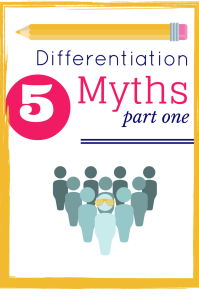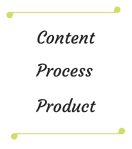The learning differences, preferences, and varied backgrounds existent in the classroom present teachers with a challenging task: help every student become a successful learner. How can teachers support all students’ diverse needs? Much confusion and fear have surrounded differentiated instruction and its use in the classroom.
task: help every student become a successful learner. How can teachers support all students’ diverse needs? Much confusion and fear have surrounded differentiated instruction and its use in the classroom.
Myth #1: Differentiation = Individualization
Differentiation doesn’t mean individualizing the curriculum for each student. Yes, when teachers meet one-on-one and conference with students, modifying instruction to best suit the student’s needs, both individualization and differentiation are taking place. However, writing an individual lesson plan for every student in the classroom is NOT differentiating (it’s insanity). Instead, differentiation involves using quality and effective instructional practices to strategically address groups of students based on various levels of learning readiness, interests, and learning styles.
 Myth #2: Every student should be doing something different
Myth #2: Every student should be doing something different
Teachers should consider each student’s strengths and areas that need support, but that does not mean 30 students are engaged in 30 different activities. Instead, teachers use differentiation to provide a range of activities and assignments that challenge and offer variety in students’ learning opportunities. This includes flexible grouping, or organizing students by ability, learning styles, and academic needs. Students may work individually, in pairs, collaborative groups, or as a class based on learning objectives and their individual needs and preferences. For example, one group may be practicing math skill fluency while another group is applying this skill within more challenging settings. Differentiation also involves modifying the content (the what), process (the how), and product (the end result). Using assessment to inform instruction, providing leveled reading books, increasing or decreasing task complexity, and assigning tasks based on visual, auditory, and kinesthetic learning preferences all support such differentiated learning opportunities.
Myth #3: Test prep doesn’t allow you to differentiate
Differentiation’s first objective is to help students deeply understand the content. This is essential to encourage the progressive achievement of a desired level of mastery in preparation for students’ successful careers and futures. Differentiated instruction better prepares students for standardized tests through authentic learning experiences that exercise higher-order, critical thinking skills and encourage the development of strong conceptual understanding. Secondly, differentiation aims to prepare students for varied forms of assessment, including group projects and research papers, as well as multiple-choice questions on a standardized test. Therefore, using standardized testing preparation to assess and monitor students’ progress and understanding is important, but it is only one of the many types of assessment teachers use. Undifferentiated or standardized assessments should be provided along with authentic and performance-based assessments.
Myth #4: There is no time to differentiate
Differentiation doesn’t have to be thought of as separate from instruction. The key is to treat differentiation as a core part of the lesson and unit plan, rather than as an afterthought. The best answer is to start small, such as differentiating one subject or unit at a time by modifying the plans and materials you already have. Even though a teacher may feel he/she has little control over the content, differentiating instruction can support how he/she will teach it.
Myth #5: Differentiation is the end-all-be-all solution for academic achievement
Differentiation is one way to help all students of varying abilities, learning styles, interests, and background experiences meet or exceed grade-level expectations. Parent engagement, assessment, reflection, professional development, and content and grade-level collaboration are all part of the toolbox schools and teachers need to proactively anticipate and appropriately respond to students’ continuously changing needs.
What does differentiation look like in action? This is Part 1 of 2 posts about differentiation and how it is used in the classroom.
Cash, R. M. (2011). Advancing differentiation: Thinking and learning for the 21st century. Minneapolis, MN: Free Spirit Publishing, Inc.
 Veronica has a degree from Mount Saint Mary College and joined LEE & LOW in the fall of 2014. She has a background in education and holds a New York State childhood education (1-6) and students with disabilities (1-6) certification. When she’s not wandering around New York City, you can find her hiking with her dog Milo in her hometown in the Hudson Valley, NY.
Veronica has a degree from Mount Saint Mary College and joined LEE & LOW in the fall of 2014. She has a background in education and holds a New York State childhood education (1-6) and students with disabilities (1-6) certification. When she’s not wandering around New York City, you can find her hiking with her dog Milo in her hometown in the Hudson Valley, NY.


One thought on “5 Harmful Differentiation Myths: Part 1”
Comments are closed.